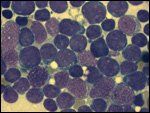ASCO 2011: High-Dose Methotrexate May Benefit Young ALL Patients
Despite dramatic improvements in survival for children and young adults with acute lymphoblastic leukemia (ALL), treatment failure in the central nervous system remains a constant foe.
Despite dramatic improvements in survival for children and young adults with acute lymphoblastic leukemia (ALL), treatment failure in the central nervous system remains a constant foe.

Bone marrow smear (large magnification) from a patient with acute lymphoblastic leukemia; image source: Wikimedia Commons user Furfur
But a new approach to control involvement at this vulnerable site may be emerging. Researchers highlighted the potential benefits of high-dose methotrexate, including a lack of significant side effects, during a presentation on Sunday at the American Society of Clinical Oncology (ASCO) Annual Meeting in Chicago.
ALL is a very rare disease. Only about 5,300 new cases are reported each year in the US, with those under the age of 20 accounting for 60% of the sufferers.
"After being uniformly fatal in the 1950s, survival of children with ALL has increased dramatically over the last 60 years," said Eric C. Larsen, MD, director of the Maine Children's Cancer Program at Maine Medical Center in Scarborough and lead author of abstract 3.
Today, survival rates hover around 80%. Methorexate, in various combinations and intensities, has remained a cornerstone of treatment since its introduction more than 50 years ago.
"The cure of most children with ALL represents one of the great triumphs in treatment of malignant disease," Martin S. Tallman, MD, chief of the leukemia service at Memorial Sloan-Kettering Cancer Center in New York City, told the audience during a discussion session.
"But the issue of CNS control is an important one," added Dr. Tallman, who was not involved in the study. "A proportionally high rate of relapse has been observed even though marrow disease has improved."
In the new study, Dr. Larsen and his colleagues focused their attention on strategies to enhance this CNS control. They randomized 3,154 patients between the ages of 1 and 30 with newly diagnosed high risk B-precursor ALL to either dexamethasone (DEX) or prednisone (PRED) during induction and high-dose methotrexate or Capizzi escalating methotrexate plus PEG asparaginase during interim maintenance-1.
A planned interim analysis of 2,426 patients showed that the 5-year event-free survival for patients randomized to high-dose methotrexate was far better than those receiving Capizzi methotrexate plus asparaginase: 82% versus 75% (P = .006).
Further, fewer marrow and CNS relapses occurred in the high-dose methotrexate group: 42 vs 68 and 22 vs 32, respectively. There was no increase in acute toxicity with the higher dose of methotrexate.
The superior response led the research team to halt enrollment and allow patients on the inferior treatment arm to cross over to high-dose methotrexate.
"This study establishes a new standard of care for children with high-risk ALL," said Dr. Tallman.
Dr. Tallman did point out some limitations to the study, including the small number (2%) of patients under the age of 20, as well as a lack of information on molecular genetics and T-cell ALL.
Still, he highlighted an important lesson provided by the young participants: "They have taught us that important advances can occur without new agents, but with different uses of old ones."